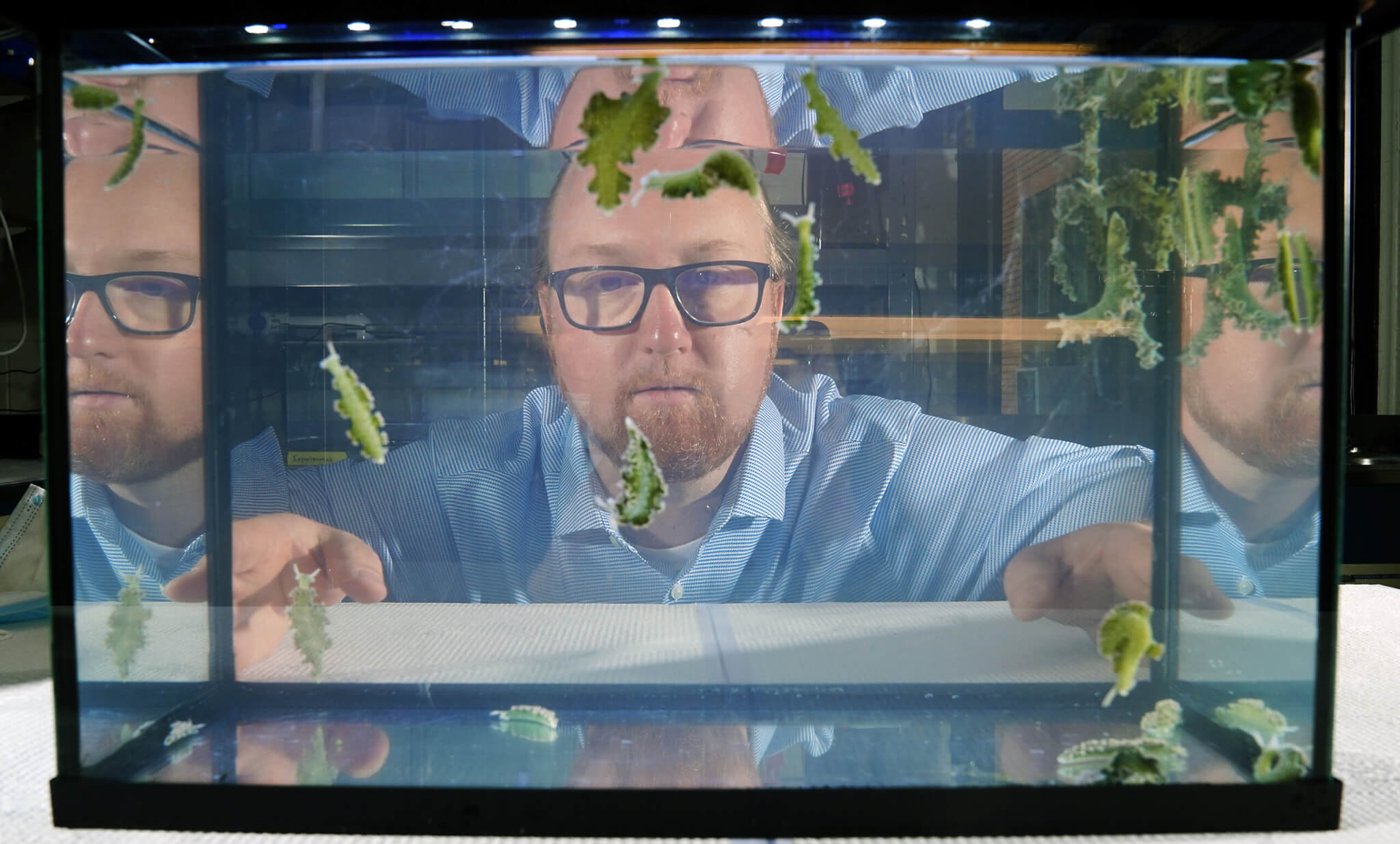You’ve probably heard the old adage: “You are what you eat.” Several species of sacoglossan sea slugs have taken that literally.
Purdue’s Josh Widhalm (@WidhalmLab), an assistant professor of horticulture and member of the Center for Plant Biology, studies Elysia clarki sea slugs, which steal the photosynthetic parts of their algal meals through a process aptly coined “kleptoplasty.” For days, weeks and possibly even months, these creatures retain these algal chloroplasts and can capture energy from the sun much like plants.
Widhalm and colleagues believe that by determining how and why the slugs perform this rare feat, they can make progress in next-generation biosynthetic biology. There could be widespread applications, from agriculture to pharmaceuticals and climate change to treating mitochondrial diseases.

“If this occurs in nature, there is a blueprint for us to study,” Widhalm said. “First and foremost, this is cool biology, and understanding kleptoplasty will shed new light on the plasticity of cells. We may also be able to use this new knowledge to determine how to introduce foreign organelles into a new host cell. If we can do that, the possibilities are endless.”
HOW IT WORKS
When animals eat, they tend to mash up plants, swallow and digest. Photosynthetic sea slugs, however, do something special.
The slug larvae feed on algae and digest everything except the algal chloroplasts, the cell organelles responsible for photosynthesis. The larvae then integrate the chloroplasts into their own cells distributed throughout their bodies.

from algae and incorporate the organelles into
their own cells. This allows the slugs to harness
energy through photosynthesis or fix carbon
dioxide into products useful to the slugs.
(Purdue Agricultural Communication photo/Tom Campbell)
“The slugs may use these chloroplasts to capture energy from the sun and/or to fix carbon dioxide into products that can be incorporated into the slug’s metabolism,” Widhalm said. “Or, they may instead serve as some sort of food reserve. In either case, there is fascinating biology to be discovered.”
While chloroplast thievery by sea slugs has been known about for a long time, little information exists about the molecular biology underlying kleptoplasty. Widhalm is interested in determining how the slugs recognize and separate the chloroplasts, if and how the slug cells communicate with the alien chloroplasts, and how the slugs evolved the ability to harness the chloroplasts.
This work started when Widhalm was invited in 2018 to become a Scialog Fellow. These scholars are chosen from multiple disciplines and institutions across the U.S. and Canada to maximize creative thinking and innovative ideas. At a Scialog meeting sponsored by Research Corporation for Science Advancement and the Gordon and Betty Moore Foundation, he met other fellows and together answered a call for proposals for projects that would pose big questions in cell biology and develop new systems to answer them. Widhalm and collaborators Markita Landry from the University of California Berkeley and Purdue alumnus Jing-Ke Weng from the Massachusetts Institute of Technology received funding for their sea slug work.
“These were high-risk, high-reward proposals,” Widhalm said. “Not only can we learn a lot about basic cell biology, but there are opportunities to put that knowledge to use in so many ways.”
POTENTIAL USES
Transferring the sea slugs’ ability to retain chloroplasts in their cells to other organisms or synthetic cells has the potential to usher in a “giant leap” for synthetic biology, with the lessons learned being applicable to so many other areas.
Photosynthesis requires light and carbon dioxide. If photosynthesis could be introduced as a trait packaged and delivered via organellar transfer, designer cells could be engineered to pull carbon dioxide from the atmosphere and impact climate change.
Mitochondrial diseases affect a cell’s ability to produce energy. Understanding how to insert organelles without damaging the host cell could allow for new clinical treatments for repairing or replacing defective organelles in those suffering from hard-to-treat illnesses.
Drug development might also be improved. Yeast and microbial cells often need sugars to consume during the process of creating new molecules. Eliminating the need for fixed carbon input could improve the sustainability and cost efficiency of engineering valuable products.
Widhalm and his graduate students have spent the last year working with a single aquarium setup and attempting to successfully rear sea slugs through their life cycles in captivity. They’ve now gotten the creatures to reproduce and the offspring to feed on cultured algae and metamorphose into green adults.
Now, Widhalm has obtained funding to develop a more elaborate aquarium system with multiple areas for culturing algae, holding slugs at different stages of their lives and monitoring water chemistry.
With support from a 2020 Showalter Research Trust award, Widhalm’s team is focused on answering questions about sea slug cell biology. In addition to their team award from Research Corporation, Widhalm, Landry and Weng were also recently funded by The Gordon and Betty Moore Foundation to develop tools for studying sea slug genes. Through a Center for Plant Biology seed grant, Widhalm is also working with collaborator Jennifer Wisecaver, assistant professor of biochemistry, to sequence the Elysia clarki genome.
“We can learn so much about whether the slugs modify the chloroplasts in any way before taking them in and how they control chloroplast function,” Widhalm said. “It’s early in the work, but with our new setup and the tools we are developing with our collaborators, we expect to learn a lot about this awesome evolutionary phenomenon.”